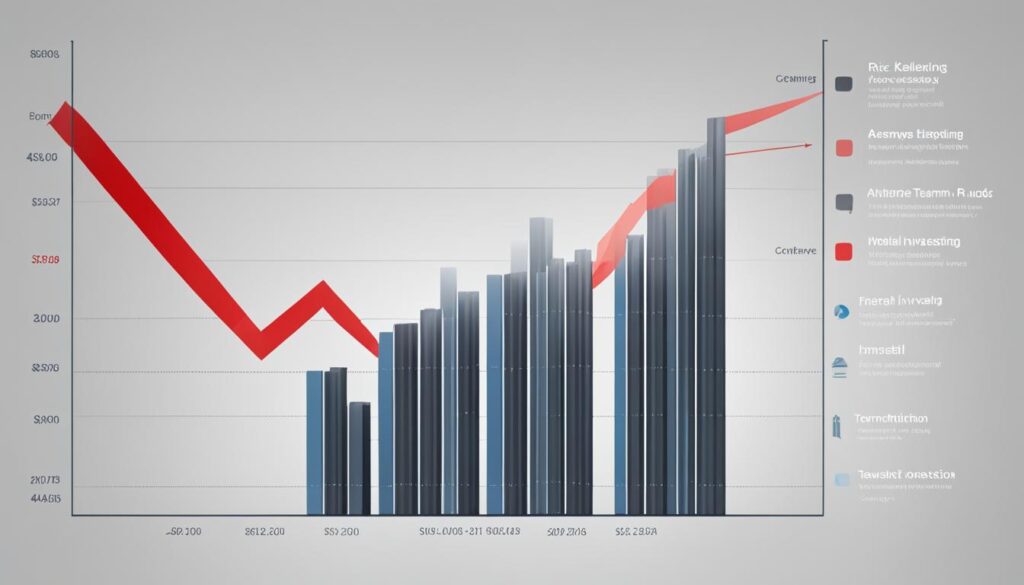Short selling is a technique in the stock market that allows investors to profit from the declining prices of stocks. This strategy involves borrowing stocks from a broker and selling them on the open market, with the hope of buying them back at a lower price in the future. Short selling can be a profitable strategy, but it also carries significant risks and should be approached with caution
Key Takeaways:
- Short selling is a strategy that allows investors to profit from declining stock prices
- This technique involves borrowing stocks from a broker and selling them on the open market
- Short selling carries significant risks and should be approached with caution
- Alternative strategies like buying put options or using inverse ETFs exist
- Only experienced investors should engage in short selling
Introduction to Short Selling
Short selling is a popular investment strategy in the stock market that allows investors to profit from declining prices. It involves borrowing stocks from a broker and selling them on the open market with the expectation of buying them back at a lower price in the future. This technique is based on the belief that a stock’s price will decrease, enabling the investor to generate profits from the price difference.
The stock market provides opportunities for investors to profit from both rising and falling prices. While traditional investing involves buying stocks with the hope that their value will increase over time, short selling allows investors to bet against the market. By taking a short position, investors can capitalize on declining stock prices and potentially generate substantial profits.
To execute a short sale, investors must first borrow the desired number of shares from a broker. These borrowed shares are then sold on the open market, with the expectation that their price will decrease. Once the stock price has fallen to the desired level, the investor buys back the shares and returns them to the broker, pocketing the difference as profit.
Short selling is not without its risks. If the price of the borrowed shares increases instead of decreasing, the investor may be forced to buy them back at a higher price. This situation, known as a short squeeze, can result in significant losses. Therefore, it is crucial for investors to approach short selling with caution and conduct thorough research before executing any trades.
| Pros of Short Selling | Cons of Short Selling |
|---|---|
| Profit from declining stock prices | Potential for unlimited losses |
| Ability to bet against the market | Increased risk compared to traditional investing |
| Can be used to hedge against market downturns | Possibility of short squeezes |
Despite the risks involved, short selling can be a valuable tool for experienced investors looking to profit from declining stock prices. It is essential to understand the mechanics of short selling, conduct thorough research, and develop a well-thought-out strategy before engaging in this high-risk investment technique.
Understanding Risk Arbitrage
Risk arbitrage is a trading strategy that involves taking advantage of price discrepancies in the market to profit from buying and selling securities. It is a popular investment technique among hedge fund managers and institutional investors who are skilled at identifying and capitalizing on these discrepancies.
At its core, risk arbitrage involves buying and selling securities of companies that are involved in a merger or acquisition. The goal is to profit from the price difference between the current market price and the acquisition price. This strategy assumes that the market has not yet fully priced in the value of the deal, allowing investors to take advantage of the potential upside.
To illustrate the concept of risk arbitrage, consider the following example:
“Company A announces its intention to acquire Company B for $50 per share. However, the current market price of Company B is only $40 per share. An investor could buy Company B shares at $40 and then sell them to Company A at $50, making a profit of $10 per share.”
This example highlights how risk arbitrage can generate profits by capitalizing on the price discrepancy between the current market price and the acquisition price. However, it is important to note that risk arbitrage is not without its own set of risks. The success of this strategy relies on the completion of the merger or acquisition and the market’s reaction to the deal.
Overall, risk arbitrage can be a lucrative trading strategy when executed correctly. It requires a deep understanding of the companies involved, careful analysis of market conditions, and the ability to seize opportunities when they arise. Like any investment strategy, risk arbitrage carries its own set of risks, and investors should approach it with caution and conduct thorough due diligence before making any trading decisions.
Note: The image above illustrates the concept of risk arbitrage with a visual representation of the process and the potential profit opportunity.
The Mechanics of Short Selling
Short selling is a trading strategy that involves borrowing shares from a broker and selling them on the open market. This technique allows investors to profit from the declining prices of stocks. The mechanics of short selling involve several key steps:
- Borrowing shares: The first step in short selling is to borrow shares from a broker. This is done by entering into a borrowing agreement, where the investor agrees to return the borrowed shares at a later date.
- Selling on the open market: Once the shares are borrowed, the investor sells them on the open market. This is typically done through a brokerage account, where the shares are listed for sale.
- Waiting for the price to fall: After selling the borrowed shares, the investor waits for the price of the stock to fall. The goal is to buy back the shares at a lower price in the future.
- Buying back the shares: When the price of the stock has fallen, the investor buys back the shares at the lower price. The shares are then returned to the broker to fulfill the borrowing agreement.
The difference between the price at which the shares were sold and the price at which they were bought back represents the profit or loss made from short selling.

It’s important to note that short selling is a high-risk strategy. If the price of the stock rises instead of falling, the investor will have to buy back the shares at a higher price, resulting in a loss. Additionally, there is no limit to the potential losses in short selling, as the price of a stock can theoretically increase infinitely.
Short selling is like playing with fire. It can be highly profitable if done correctly, but it can also lead to significant losses. Investors need to carefully analyze market trends and stock performance before engaging in short selling.
Margin Requirements and Risks
Short selling also involves margin requirements, which are the minimum amount of equity that must be maintained in the brokerage account. Margin requirements vary depending on the broker and the stock being shorted. If the value of the shorted stock increases and the account’s equity falls below the margin requirement, the investor may receive a margin call and be required to deposit additional funds to meet the margin requirement.
Furthermore, short selling carries the risk of a short squeeze. A short squeeze occurs when there is a sudden increase in the price of a heavily shorted stock. In this scenario, short sellers rush to cover their positions by buying back the shares, which further drives up the price of the stock. This can result in significant losses for short sellers who are forced to buy back the stock at inflated prices.
| Advantages | Disadvantages | |
|---|---|---|
| Advantages of Short Selling |
|
|
Short selling can be a powerful tool in a skilled investor’s toolbox, but it requires careful analysis, risk management, and market knowledge. It is crucial for investors to thoroughly understand the mechanics of short selling and be aware of the significant risks involved before implementing this strategy.
Risks and Rewards of Short Selling
Short selling can be a highly lucrative strategy if executed correctly, but it is not without its risks. One of the main risks of short selling is the potential for unlimited losses. Unlike traditional investing where the maximum loss is the amount initially invested, short selling has no limit to how much you can lose. If the price of the stock you have shorted rises instead of falling, you may be forced to buy back the shares at a higher price, resulting in a significant loss.
Another risk to consider is the possibility of a short squeeze. A short squeeze occurs when a large number of investors are shorting a particular stock, and the price begins to rise rapidly. In this situation, these investors are forced to buy back the shares at higher prices to cover their positions, further driving up the stock price. This can create a reinforcing cycle where more and more short sellers are compelled to close their positions, leading to even higher prices.
“Short selling carries significant risks, including the potential for unlimited losses and the risk of short squeezes.”
It’s important to understand that short selling requires careful analysis and timing. It should only be considered by experienced investors who have a deep understanding of the market and are willing to accept the potential risks. It is crucial to closely monitor market conditions, track company news, and have a clear exit strategy in place to mitigate these risks.
The Risks of Short Selling in Numbers
| Risk | Impact |
|---|---|
| Unlimited losses | The potential for significant financial loss if the stock price rises instead of falling. |
| Short squeeze | Investors may be forced to buy back shares at higher prices, leading to further increase in stock price. |
| Inability to find shares to borrow | Difficulty in finding shares to borrow in order to execute a short sale can limit opportunities and increase costs. |
| Margin calls | If the value of your short position increases significantly, your broker may require additional funds to cover potential losses. |
Despite the risks involved, short selling can be a valuable tool for experienced investors to manage risk and potentially profit from falling stock prices. However, it is crucial to thoroughly understand the risks, closely monitor market conditions, and exercise caution when employing this strategy.

Strategies and Alternatives to Short Selling
Short selling can be used as part of a larger investment strategy to hedge against market downturns or to profit from specific market trends. However, it is important to consider alternative strategies and approaches that can provide similar benefits while mitigating some of the risks associated with short selling.
One alternative to short selling is buying put options. Put options give investors the right, but not the obligation, to sell a specific stock at a predetermined price within a certain time frame. This strategy allows investors to profit from a decline in the stock’s price without actually owning the shares. Put options can be a more flexible and controlled way to bet against a stock compared to short selling, as the investor’s potential loss is limited to the premium paid for the options.
Another alternative to short selling is the use of inverse exchange-traded funds (ETFs). Inverse ETFs are designed to provide returns that are the inverse of a specific index or benchmark. For example, an inverse ETF that tracks the S&P 500 would aim to deliver the opposite return of the index. By investing in inverse ETFs, investors can gain exposure to market downturns without having to engage in short selling. However, it is important to note that inverse ETFs come with their own risks and may not perfectly track the inverse of the underlying index.
Futures contracts are also a popular alternative to short selling. Futures contracts are agreements to buy or sell an asset at a predetermined price on a future date. By entering into a futures contract to sell a specific stock, investors can profit from a decline in the stock’s price without actually owning the shares. Futures contracts can be a leveraged and efficient way to bet against a stock, but they also come with their own risks and complexities.
Comparing Short Selling Strategies and Alternatives
| Strategy | Risk | Reward |
|---|---|---|
| Short Selling | Unlimited losses if the stock price rises | Potential for significant profits if the stock price declines |
| Buying Put Options | Limited loss to the premium paid for the options | Potential for profit if the stock price declines |
| Inverse ETFs | Risk of tracking error and potential losses not aligning perfectly with the inverse of the underlying index | Potential for profit if the underlying index declines |
| Futures Contracts | Leveraged exposure and potential for significant losses if the trade goes against the investor | Potential for profit if the stock price declines |
It is important for investors to carefully consider their risk tolerance, investment objectives, and overall market outlook when deciding on the most suitable strategy or alternative to short selling. Each approach has its own risks and benefits, and there is no one-size-fits-all solution. Consulting with a financial advisor or investment professional can help investors navigate the complexities of these strategies and make informed decisions.

Conclusion
Short selling is a high-risk, high-reward strategy in the stock market that allows investors to profit from declining prices. However, it is important to approach short selling with caution, as it carries significant risks. Unlimited losses and the potential for short squeezes are two key risks that investors should carefully consider.
Despite the risks, short selling can be a profitable strategy when used by experienced investors who understand the potential pitfalls. It is crucial to have a clear understanding of the mechanics and strategies involved in short selling, as well as to explore alternative options such as buying put options, using inverse exchange-traded funds (ETFs), or utilizing futures contracts.
In conclusion, short selling should not be taken lightly. It requires careful analysis, risk management, and a thorough understanding of the market. Investors should weigh the potential rewards against the risks before venturing into the world of short selling. By doing so, they can make informed decisions and navigate this high-risk art of betting against the market.
FAQ
What is short selling?
Short selling is a technique in the stock market that allows investors to profit from the declining prices of stocks. It involves borrowing stocks from a broker and selling them on the open market, with the hope of buying them back at a lower price in the future.
How does short selling work?
Short selling works by borrowing shares from a broker and selling them on the open market. The investor then waits for the price of the stock to fall, at which point they can buy back the shares at a lower price and return them to the broker. The difference between the sale price and the purchase price is the profit.
What are the risks of short selling?
Short selling carries significant risks, including the potential for unlimited losses. If the price of the stock rises instead of falling, the investor will have to buy back the shares at a higher price, resulting in a loss. Short selling also carries the risk of a short squeeze, where a rising stock price forces investors to buy back shares at a higher price, further driving up the stock’s price.
Are there alternatives to short selling?
Yes, there are alternatives to short selling. These include buying put options, using inverse exchange-traded funds (ETFs), or using futures contracts. Each alternative has its own risks and benefits, and investors should carefully consider their options before choosing a strategy.
Should I use short selling in my investment strategy?
Short selling is a high-risk strategy that should be approached with caution. It is best suited for experienced investors who understand the risks involved. Careful consideration should be given to the alternatives to short selling and a clear understanding of the mechanics and strategies involved.
How Does Short Selling Relate to Equity Investments in the Stock Market?
Short selling is a strategy used in the stock market to profit from declining prices. It involves borrowing shares from a broker and selling them, with the intention of buying them back at a lower price. By incorporating short selling into equity investments, investors can generate profits even when the stock market basics are experiencing a downturn.

